various kits
[ Page 1 ]
Fouga Magister in 1/72 scale: kit modelling report of various kits
page 2
page 3
page 4
The Magister CM.170 was designed in the 1950s as a two-seat jet trainer aircraft by the French aircraft company Fouga (Potez). It was the first dedicated jet trainer and first flight was in July 1952. It had a unique V- butterfly tail configuration and 2 small Turbomeca Marbore engines. Soon, orders were obtained and it was manufactured during the mergers of various French companies (including Potez, Sud aviation). Another version is the CM.175 ZÚphyr which was a carrier-capable version for the French Navy with stronger undercarriage and other canopy arrangement.
The Magister was also ordered by dozens of air forces (including West-Germany, Finland). Potez took over Fouga in 1958. License production was at Union Sud in West-Germany, Valmet in Finland and IAI producing the Tzukit for Israel. Magisters were used in several wars across the Globe. Including 13 prototypes, 862 Magisters were manufactured. Many air forces used the Magister and some Magisters are still flying.
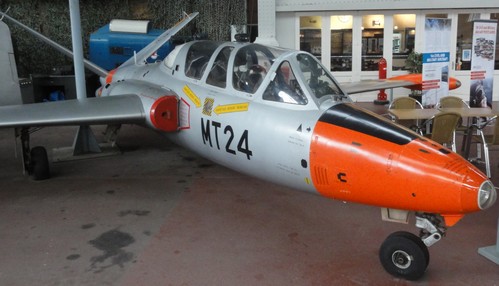
Belgian Magister coded MT24 (serial 281) photographed by me at the Brussel Air Museum, Legermuseum Jubelpark (2017)
Length 10,06 m; span 11,4 m; empty weight 2150 kg, MTOW about 3200 kg.

In 1973 Amodel from West-Germany came with a rudimentary 1/72 vacuform. Soon in 1975, it was followed by a nice Airfix injection moulded kit, with first release no. 02047. It was a basic kit that is still around and has been released in several boxes with various decals but still the same plastic parts.
From France HELLER came with a nice 1/72 Magister in 1980. It also was released during the years in various boxes no.220.
Special Hobby came in 2013 also with 1/72 Magister kits in several released. They have a Magister and Zephyr version as well.
VALOM also came with Magister kits, the first in 2013.
As a whole pile of Magister kits were available, this modelling report will cover Airfix, Heller (and later in the future the Special Hobby kits). They will be built in various exotic leveries with much inspiration coming from an extensive decal sheet #7223 of MAX DECALS:
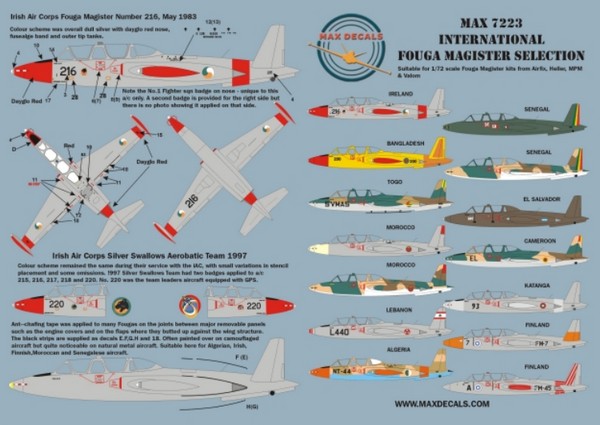
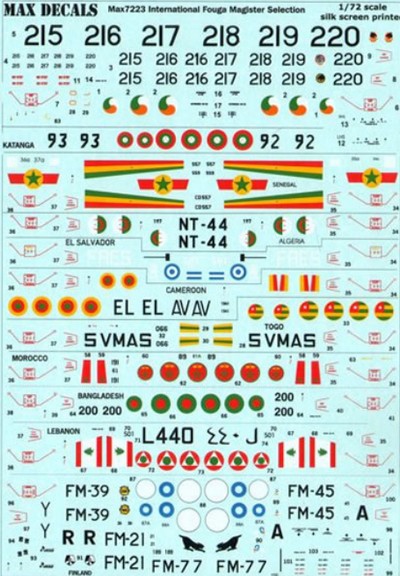
Some details to consider when building the Magister kits are:
- nose grips (or antennas?) not always fitted;
- 2 small pitots in front of the wind screen;
- small or large wing tip tanks;
- different antenna layouts with sometimes a long wire antenna below the fuselage; Magisters also often had 2 ADF aerials on the nose.
- tiny wire antenna on the spine (can be made from a piece of fishing line);
- armed Magisters often had 2 7.62mm gun barrels at the nose;
- some armed Magisters could carry rockets, bombs and rocket pods below the wing.
Consider for the model also: closed canopies or opened up; open canopies needed considerable effort to get good results on the old kits.


AIRFIX
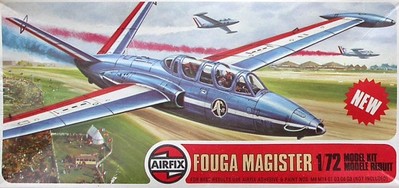
The 1/72 Airfix kit dates back from 1975. The kit release 02047-5 had decals for
-1- Belgian Air Force CM.170
-2- West-German Magister
, both in a metallic scheme. The decals are now rather old.
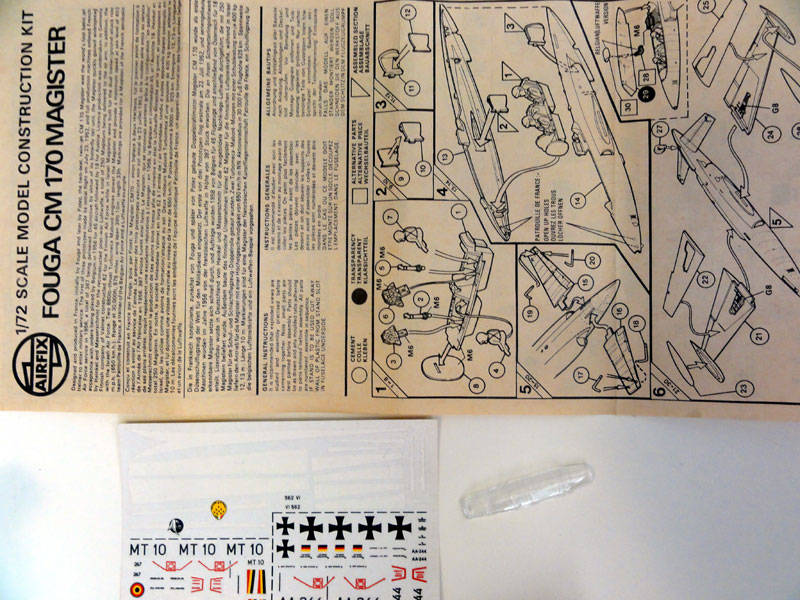
The latest Airfix release A03050 of 2014 has new very nice decals but still the same plastic parts of the very old kit.
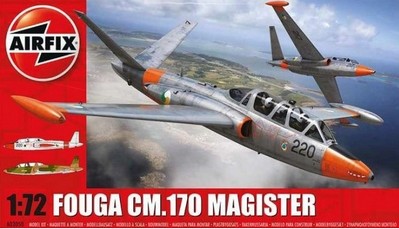
It has decals for:
-1- Ireland (Aer-Chˇr na h-╔ireann) of the Silver Swallows Aerobatic team based at Casement aerodrome - Baldonnel around 1997 in a metal scheme;
-2- Belgium Air Force as based at Bierset around 1983 in a camouflage scheme.



The Airfix 1/72 kit has about 50 parts. It has a basic cockpit with no seperate seats but as the cockpit is small this is no problem and the interior is very dark, "coal black". The Magister did not have ejection seats, the pilot had to jettison the canopy and bail out. The seat cushions are often not in place when the crew wore parachutes in stead, the back cushion was usually dark brown with blue and white harness straps.
Two crew figures are provided "without legs" in the kit in order to fit in. When installed, the small cockpit looks busy.
Only the smaller wing tip tanks are provided.

The canopy is one piece and rather thick clear plastic. When cut open to show opened up the 2 canopies, it is better replaced by an aftermarket one. Panel lines are raised as usual in those days but not to thick. The wheel bays are simple, the nose gear bay is undeep.
I removed the rear section "ceiling" to make it deep with a razor saw. The nose wheel door was made a bit less wide. Insert nose weight ballast to avoid a tail sitter.

The butterfly tail is better installed after sanding.
The kit needs some sanding to remove some thick raised details. Some putty/ filler is needed at the wing-fuselage joint. Also, 2 small inside jet pipes were made from a straw.
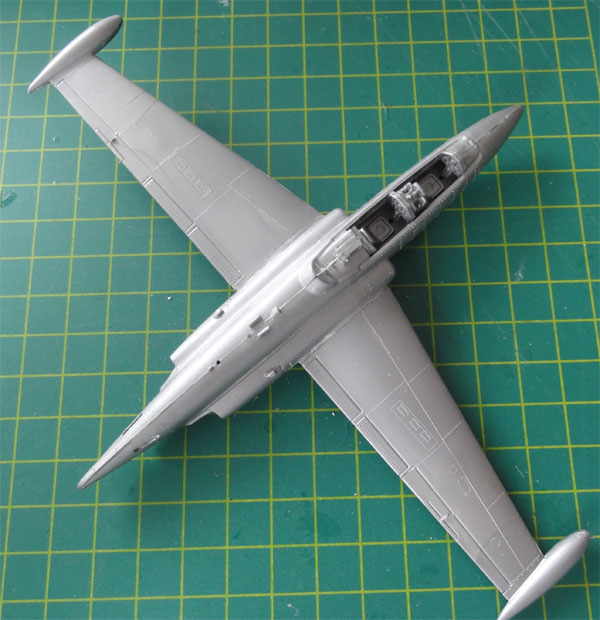
There is some detail in the main gear bays.
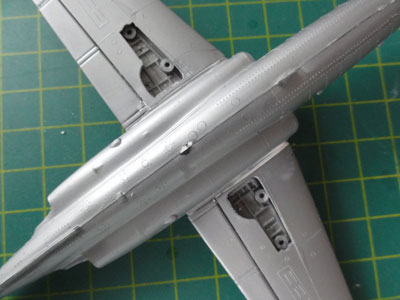
The fuselage spine needs some sanding as well as the belly.
A base grey coat (usingh Revell aqua 75 steingrau) was airbrushed to check for any small errors after sanding. It revealed some more filling and sanding was needed.
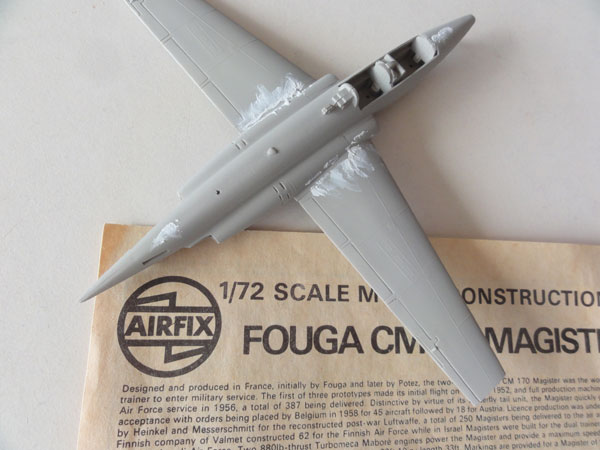
... and the result with tip tanks fitted
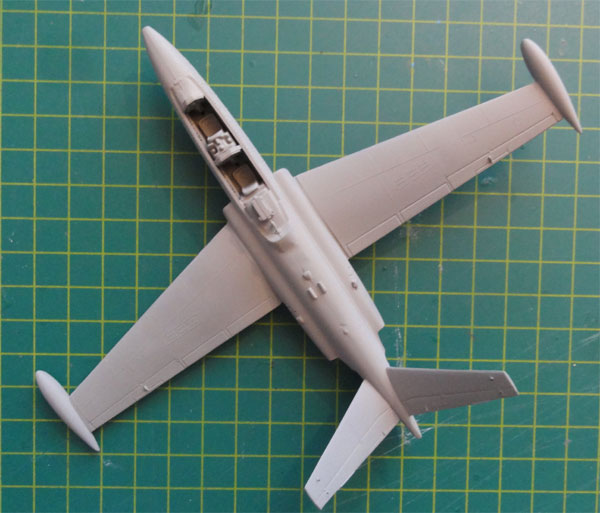
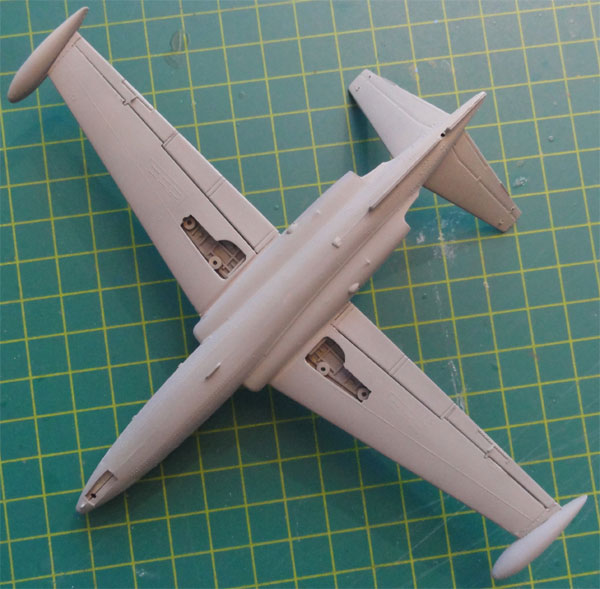
Ireland / Eire
The first Airfix kit made is of the latest release #A03050 and the Silver Swallows scheme as per kit was picked. Some 7 Magisters were acquired, some 3 ex-French and 4 ex-Austrian jets.
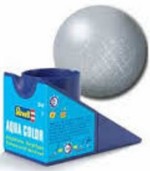
For the overall metallic look Revell aqua 11 "silber" was airbrushed. The red panels were, after masking, airbrushed Revell aqua 330 red.
The decals came mostly from the kit but I also used some decals from the MAX decal set #7223. In fact Joe Maxwell helped Airfix with their decals. Indicated is that some "black tape" was sometimes seen on this aircraft at panels, Airfix provides decals. Seen below at the engine fairings.
The smaller parts like landing gears were set and the canopy was set closed as per kit. The standard small fuel tanks are seen as per kit. The anti-collision lights on the outsides of the tips are missing in the kit, these were suggested with paint.
The ADF aerials were later painted red-white striping though decals #41 are provided as well.
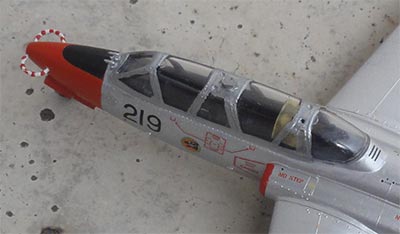
Finally, the model got a gloss varnish coat airbrushing Johnson Future/ Pledge. This gives an even sheen and protects the decals. That completed the model.
Ireland ( EIRE )
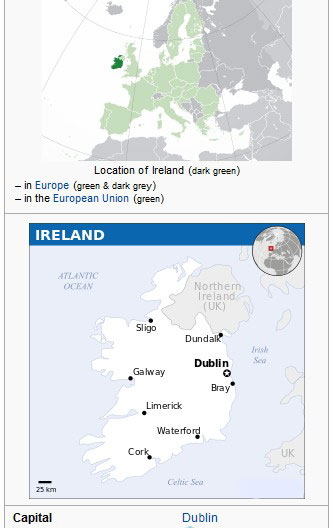

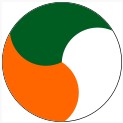
[ 70,270 sq.km | capital: Dublin | 4,7 million inhabitant | GDP $80,000 per capita]
Ireland became completely independent in 1922 and established for its army a small Air Corps with a Martinsyde Type A biplane. In 1938 a few Gloster Gladiators were acquired. During the Second World War many foreign warplanes made emergency landings and a Hudson and Fairey Battle and a few Hurricanes put into service. After the Second World War some British aircraft came into service such as Spitfires, and from 1956 Vampire jets and from 1963 Alouette III helicopters. Note that Ireland is NOT a NATO member state, remaining a bit neutral as a small country with about 4,7 million inhabitants. There were security issues though mainly internal at the North Irish border.
In 1975 7 CM.170-2 Magisters were acquired second hand from France and Austria. They could be armed with 68mm rocket pods. Some were flown by the "Silver Swallows" aerobatic display team. Most Magisters were withdrawn in 1998. Nearly a dozen SIAI Marchetti Warriors were operated from 1977 onwards and could be lightly armed with rocket pods as well. Maritime patrol aircraft like the CASA CN.235 were operated from 1995. Pilatus PC-9 trainers were acquired from 2004 but all those years it remained a small air corps. Currently a few helicopters are types like the AW.139 and Eurocopter EC135. The main base is Casement aerodrome at Baldonnel near Dublin with a secondary base at Gormanstown.
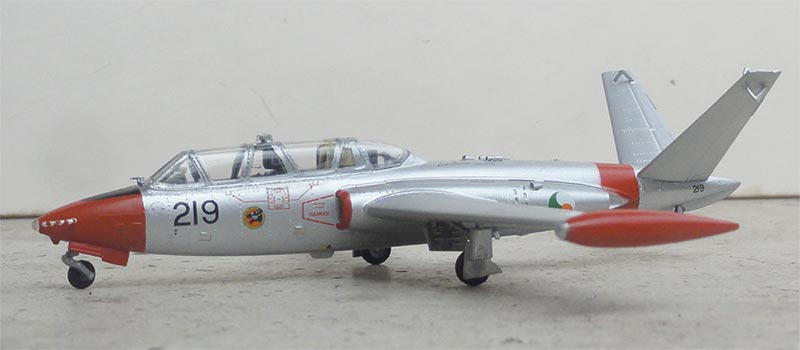
Magister CM.170-2, coded 219 (serial 298), flown by the "Silver Swallows" aerobatic display team. Operated until November 2014 and now probably in IAC heritage museum. (interesting is that the Magister serial 298 was intended to be delivered to Katanga, instead it went to Ireland/ Eire).
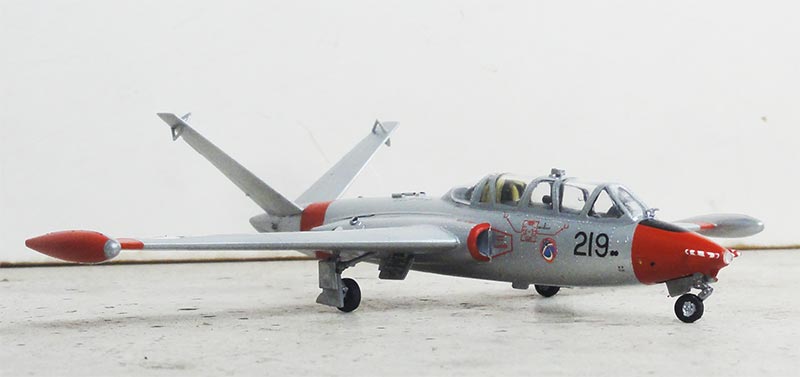
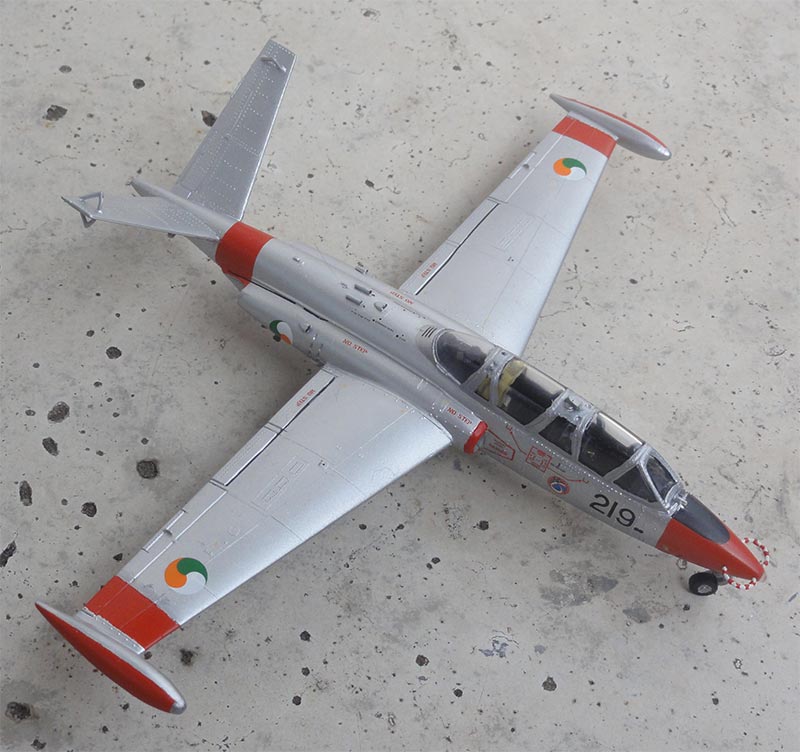

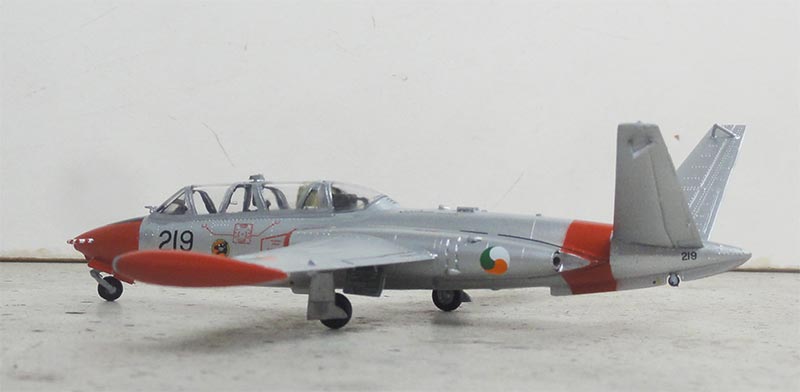
... in scenery at Baldonnel , Ireland ( EIRE ) ....
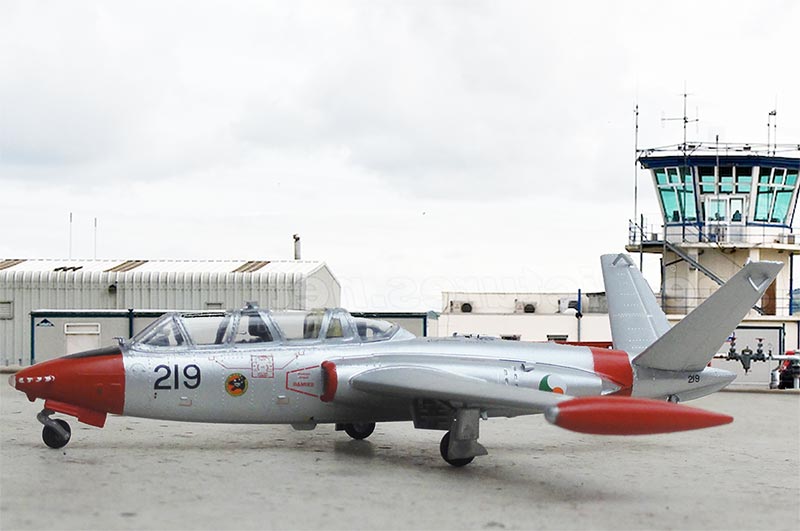
KATANGA
Another Airfix Magister was made in a scheme for the rather exotic "Katanga" Magister. It was used during the Congo Crisis in 1961.
The decals are from the Max decal set 7223. For the overall metallic look Revell aqua 11 "silber" was airbrushed. The dayglow red areas on the real aircraft were overpainted in white so after masking here airbrushed white over the silver.
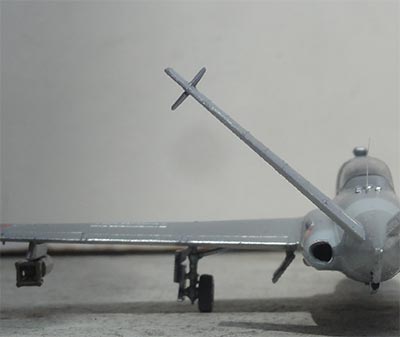
Two tiny machine gun barrells were set on the nose made from plastic rod. Also, 2 small pylons were added retrieved from the Special Hobby Magister kit as well as a small bomb (which in reality was of unknown designation).
Katanga


[ no official independent state ]
Katanga is a southern province in Congo (called Belgian King Leopold's "back yard") that declared independancy July 1960 with Belgian support as they had mining interests. Officially Belgium did not recognize this state but meanwhile supported it. A pro-secessionist Katangese Air Force (FAK) obtained three new Magisters (from a Belgian batch) and these were delivered to Katanga in February 1961; they had serials 294 (KAT-91), 295 (KAT-92) and 296 (KAT-93). Six others serial 297-302 never were delivered. One of the delivered Magisters was used against the ONUC in the September 1961 Siege of Jadotville, flown by a Belgian. The Magisters were armed with two machine guns and two locally made light bombs. It made numerous attacks on ground targets. It may be that a Magister was involved in the crash on September 18, 1961 of a DC-6 that was carrying Dag Hammarskj÷ld, the UN Secretary General near Ndola in Zambia. The Katanga Magisters were out of service after 1961.
Congo remained very unstable and until 1971 was called Congo-Kinshasa and later Zaire. Still up to today, it is a complete chaos with a lot of political unrest with also outside involvement as the country has large mines with minerals and rare metals.
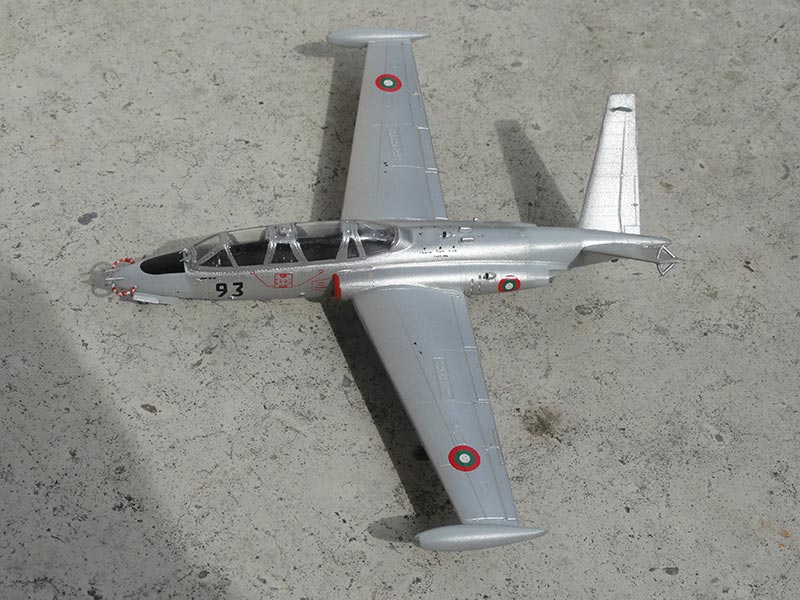
Katanga Magister, serial 296, coded KAT-93
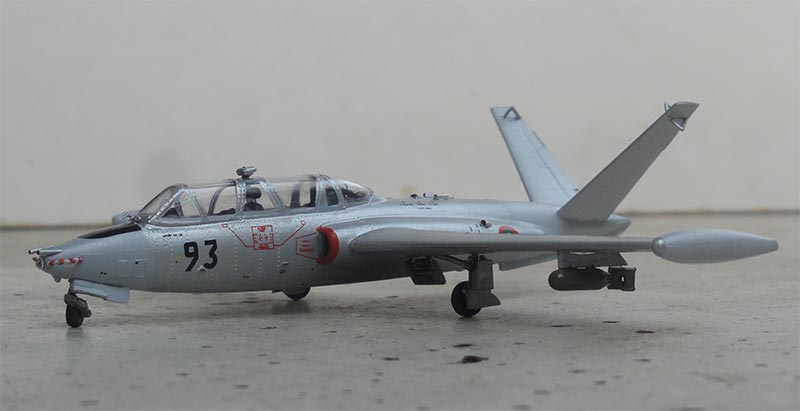
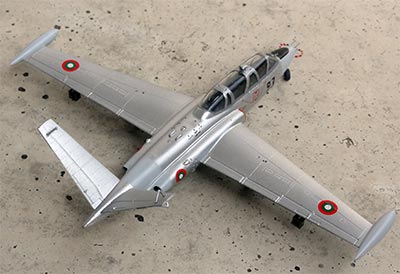
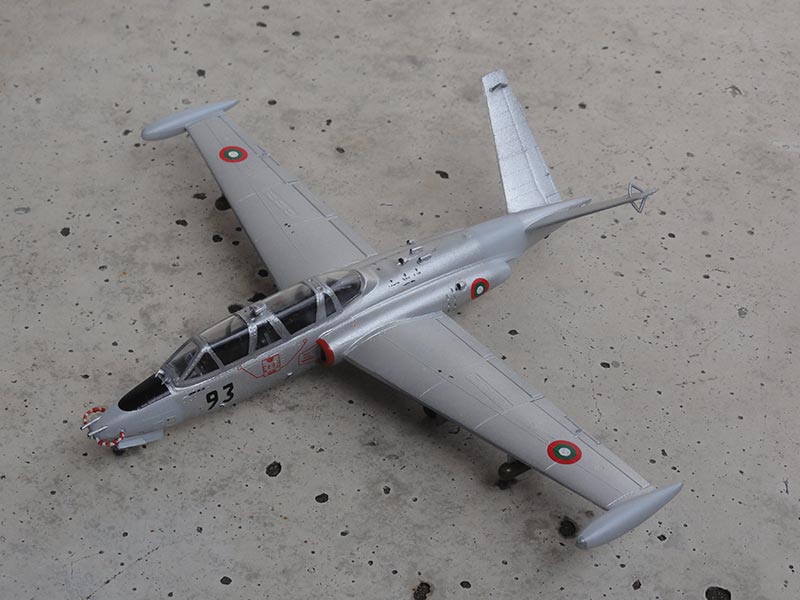
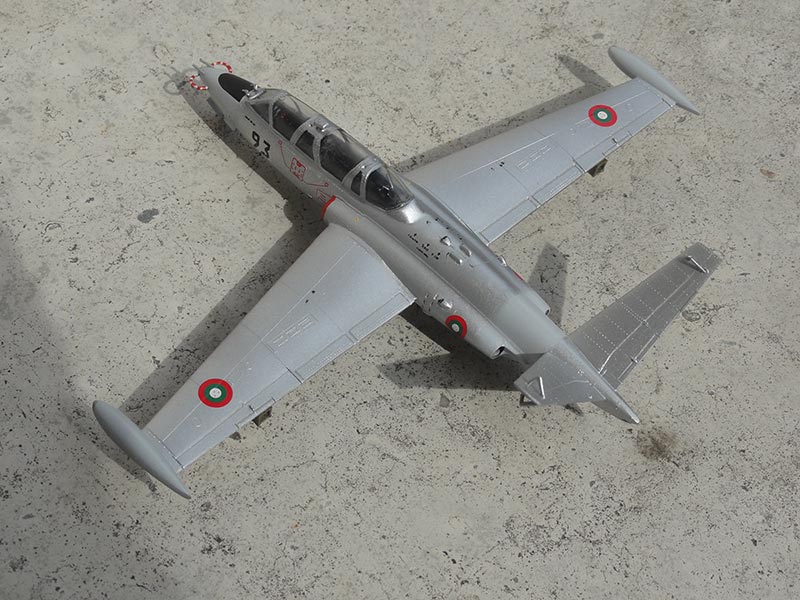
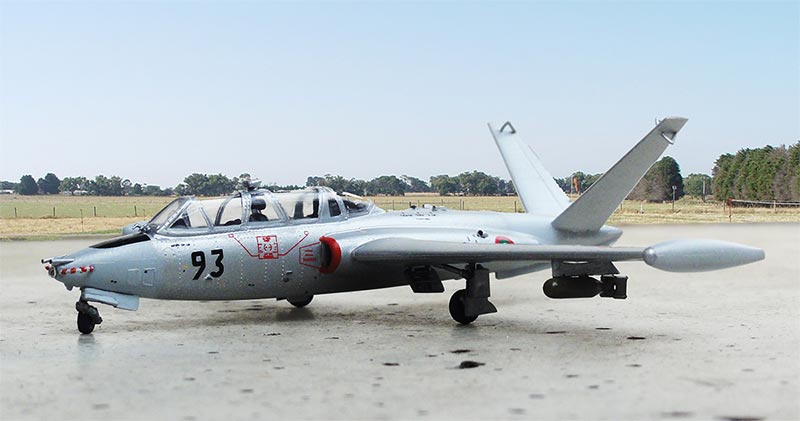
On to next [ Page 2... ]
References:
- Air International magazine: Volume 74/4; Volume 50/3 ;
- Scale Aircraft Modelling 1998 /Oct. 10.
- IPMS Belgium: KIT magazine #179
- Modern Military Aircraft, the illustrated encyclopedia of..., Bill Gunston, Salamander Books, London, 1977
and off course the Internet....
https://en.wikipedia.org/wiki/Fouga_CM.170_Magister
https://www.fouga.be/ , great website of Tine Soetaert
Back to 1/72 Models
(c) Copyright Meindert "designer"/ All rights reserved. Your comments are welcomed by webmaster
Created this page May 10, 2018